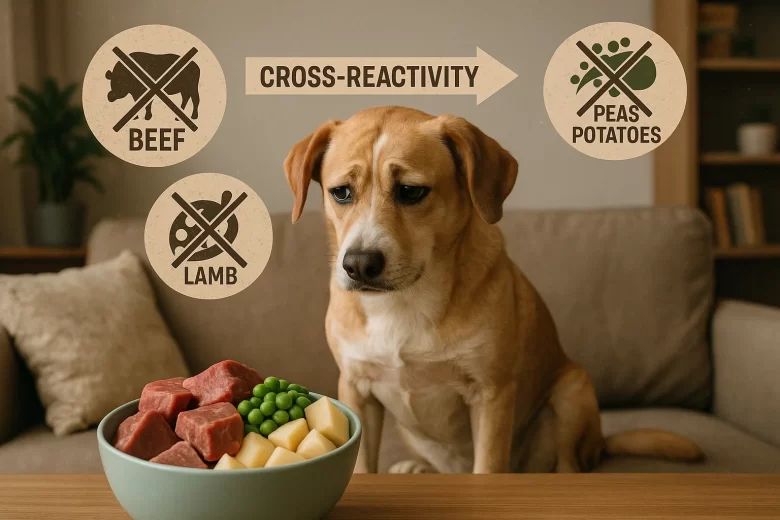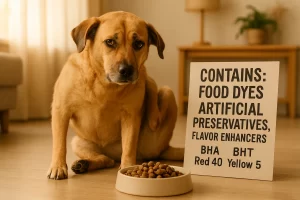As responsible pet owners, we always want to ensure that our dogs live a long, healthy life. For dogs with food allergies, identifying the right food can be a challenge. Sometimes, dogs that are allergic to one ingredient may also react to other ingredients that are structurally similar. This phenomenon is known as cross-reactivity, and it can complicate managing food allergies in dogs. In this article, we will explore what cross-reactivity is, how it affects dogs, and how to identify high-risk ingredients to keep your dog safe.
Understanding Cross-Reactivity in Dogs
Cross-reactivity occurs when a dog’s immune system mistakes a similar protein or substance in a different food as the same allergen. Essentially, the body reacts to multiple, structurally similar ingredients in the same way, even though they are different foods. This can lead to allergic reactions when a dog consumes a food ingredient that is not an immediate suspect.
For example, if your dog is allergic to beef, they may also experience a reaction to other meats, such as lamb or venison, due to the similarities in protein structures. Cross-reactivity can also extend to other types of allergens, such as plant-based proteins, grains, and even certain vegetables.
Cross-reactivity is a common phenomenon, not just in dogs but in humans as well. In fact, it’s similar to how people who are allergic to birch pollen may experience symptoms when they eat certain fruits like apples, cherries, or carrots, due to the structural similarities of the proteins.
How Cross-Reactivity Affects Dogs
When a dog experiences cross-reactivity, their immune system reacts to proteins or substances in foods that are structurally similar to an allergen they are already sensitive to. This can lead to various symptoms of an allergic reaction, which may include:
- Itchy skin or rashes
- Ear infections
- Gastrointestinal upset (vomiting, diarrhea)
- Swelling or hives
- Lethargy or fatigue
- Excessive licking or chewing of paws
These symptoms can appear shortly after your dog consumes the offending food, and in some cases, they can be quite severe. In cases of cross-reactivity, it’s important to monitor your dog’s symptoms closely and avoid exposing them to similar allergens.
Identifying High-Risk Ingredients for Cross-Reactivity
Knowing which ingredients are high-risk for cross-reactivity can help you manage your dog’s food allergies more effectively. Certain ingredients are more likely to trigger reactions in dogs due to their structural similarity to other allergens. Here are some common high-risk ingredients to watch out for:
1. Proteins (Beef, Lamb, and Venison)
If your dog is allergic to beef, they may also react to other meats like lamb, venison, and even bison. These proteins have a similar structure, which increases the likelihood of cross-reactivity. If your dog has a known allergy to beef, it’s best to avoid other red meats altogether, including:
- Lamb
- Venison
- Bison
- Goat
- Pork (in some cases)
Instead, consider trying proteins that are less likely to cause a reaction, such as turkey, duck, or fish.
2. Grains (Wheat, Corn, and Soy)
For dogs with grain allergies, cross-reactivity may occur with other grains, as they share similar protein structures. If your dog is allergic to wheat, they may also have trouble with other grains, including:
- Corn
- Soy
- Barley
- Oats
- Rye
If your dog has a grain allergy, it’s a good idea to opt for grain-free dog food made with alternative carbohydrates like sweet potatoes, pumpkin, or peas, which are less likely to cause cross-reactivity.
3. Dairy (Milk, Cheese, and Yogurt)
Some dogs have allergies or sensitivities to dairy products, which can cause gastrointestinal issues or skin problems. Dairy proteins are similar across various dairy products, so if your dog is allergic to one dairy product, it’s likely they will react to others as well. Common dairy products that may trigger cross-reactivity include:
- Milk
- Cheese
- Yogurt
- Butter
For dogs with dairy allergies, it’s important to eliminate all dairy-based ingredients from their diet and seek lactose-free alternatives if necessary.
4. Fish (Salmon, Tuna, and Trout)
Fish allergies in dogs are not uncommon, and if your dog is allergic to one type of fish, they may also react to other types. Fish proteins can be quite similar across species, making cross-reactivity a concern. If your dog is allergic to:
- Salmon
- Tuna
- Trout
- Cod
- Herring
It’s best to avoid all fish and opt for alternative protein sources like chicken, duck, or turkey. However, some dogs may be able to tolerate specific types of fish, so it’s important to consult with your veterinarian for guidance.
5. Fruits and Vegetables (Tomatoes, Potatoes, and Peas)
Some dogs with allergies to certain fruits or vegetables may experience cross-reactivity with other similar foods. For example, if your dog is allergic to tomatoes, they may also react to:
- Potatoes
- Peas
- Eggplant
- Bell peppers
These fruits and vegetables belong to the nightshade family (Solanaceae), and they contain similar alkaloid compounds that can trigger allergic reactions in sensitive dogs. If your dog has an allergy to any of these foods, avoid all nightshades to minimize the risk of cross-reactivity.
6. Tree Nuts (Almonds, Walnuts, and Cashews)
Nuts, though not commonly used in dog food, can be present in some treats or commercial dog foods. Dogs that are allergic to one type of tree nut may be at risk of cross-reactivity with others. Common tree nuts that may trigger reactions include:
- Almonds
- Walnuts
- Cashews
- Pecans
It’s important to avoid nuts altogether, as they can also pose choking hazards or cause gastrointestinal distress.
How to Manage Cross-Reactivity in Dogs
Managing cross-reactivity in dogs requires careful attention to their diet and the ingredients in the food they consume. Here are some tips for managing cross-reactivity in dogs:
1. Choose Limited Ingredient Diets
Limited ingredient diets (LID) are an excellent choice for dogs with food allergies, as they typically contain fewer ingredients, reducing the likelihood of cross-reactivity. Look for dog food brands that offer LID formulas with a single source of protein and a limited number of carbohydrates.
2. Introduce New Foods Slowly
When introducing a new food or protein to your dog’s diet, it’s important to do so gradually. This will allow you to monitor for any allergic reactions and identify any potential triggers.
3. Consult with Your Veterinarian
If you suspect that your dog is experiencing cross-reactivity, consult with your veterinarian. They can help you identify the specific allergens and recommend an appropriate elimination diet or hypoallergenic food.
4. Avoid Foods with Unspecified Ingredients
Read food labels carefully and avoid products with vague ingredients like “meat meal” or “animal fat,” as these can sometimes hide sources of cross-reactivity. Opt for foods with clearly listed ingredients, so you know exactly what your dog is eating.
Conclusion
Cross-reactivity is an important consideration for dog owners managing food allergies. By understanding how cross-reactivity works and identifying high-risk ingredients, you can help prevent allergic reactions and keep your dog healthy and comfortable. Be mindful of the foods you feed your dog, and always consult with your veterinarian when in doubt. With the right approach, you can manage your dog’s allergies and ensure they lead a happy, healthy life.



